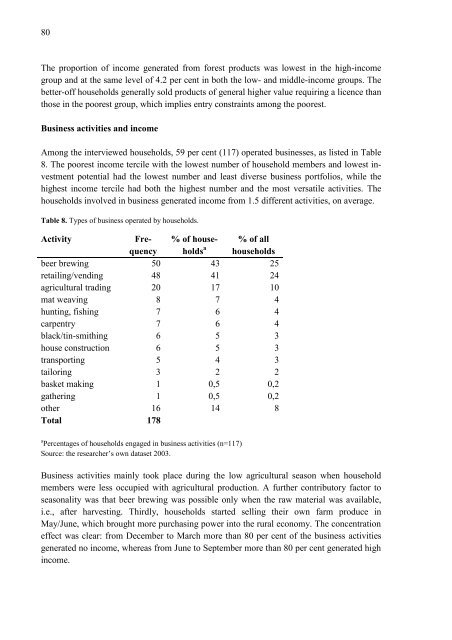Rural Income Generation and Diversification - A Case Study ... - Doria
Rural Income Generation and Diversification - A Case Study ... - Doria
Rural Income Generation and Diversification - A Case Study ... - Doria
You also want an ePaper? Increase the reach of your titles
YUMPU automatically turns print PDFs into web optimized ePapers that Google loves.
80<br />
The proportion of income generated from forest products was lowest in the high-income<br />
group <strong>and</strong> at the same level of 4.2 per cent in both the low- <strong>and</strong> middle-income groups. The<br />
better-off households generally sold products of general higher value requiring a licence than<br />
those in the poorest group, which implies entry constraints among the poorest.<br />
Business activities <strong>and</strong> income<br />
Among the interviewed households, 59 per cent (117) operated businesses, as listed in Table<br />
8. The poorest income tercile with the lowest number of household members <strong>and</strong> lowest investment<br />
potential had the lowest number <strong>and</strong> least diverse business portfolios, while the<br />
highest income tercile had both the highest number <strong>and</strong> the most versatile activities. The<br />
households involved in business generated income from 1.5 different activities, on average.<br />
Table 8. Types of business operated by households.<br />
Activity Fre- % of housequencyholds<br />
a<br />
% of all<br />
households<br />
beer brewing 50 43 25<br />
retailing/vending 48 41 24<br />
agricultural trading 20 17 10<br />
mat weaving 8 7 4<br />
hunting, fishing 7 6 4<br />
carpentry 7 6 4<br />
black/tin-smithing 6 5 3<br />
house construction 6 5 3<br />
transporting 5 4 3<br />
tailoring 3 2 2<br />
basket making 1 0,5 0,2<br />
gathering 1 0,5 0,2<br />
other 16 14 8<br />
Total 178<br />
a Percentages of households engaged in business activities (n=117)<br />
Source: the researcher’s own dataset 2003.<br />
Business activities mainly took place during the low agricultural season when household<br />
members were less occupied with agricultural production. A further contributory factor to<br />
seasonality was that beer brewing was possible only when the raw material was available,<br />
i.e., after harvesting. Thirdly, households started selling their own farm produce in<br />
May/June, which brought more purchasing power into the rural economy. The concentration<br />
effect was clear: from December to March more than 80 per cent of the business activities<br />
generated no income, whereas from June to September more than 80 per cent generated high<br />
income.

















